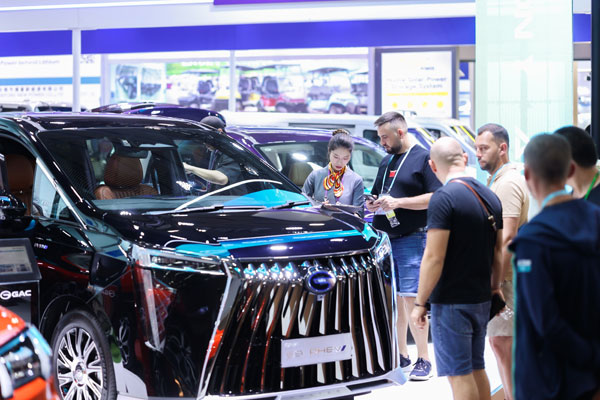Guangdong hinges on manufacturing sector for bullish momentum
Canton Fair showcases host's commercial and industrial expertise
Local enterprises showcased a variety of top-notch products and cutting-edge technologies at the first phase of the 136th China Import and Export Fair, or the Canton Fair, in Guangzhou, South China's Guangdong province, highlighting the commitment to the real economy and leadership in advanced manufacturing.
The Guangzhou trade delegation saw participation of 336 enterprises representing new quality productive forces, a 6.6 percent increase from the 135th session. Among them, Chinese automaker GAC Group presented its first global strategic model from its new energy vehicle brand Aion. It featured advanced intelligent driving functions such as urban and highway navigated driving assist and one-click remote parking.
In recent years, Guangdong has steadfastly been advancing new industrialization to establish itself as a manufacturing province. The province's industrial scale accounts for about one-eighth of China's total, with its manufacturing scale comprising nearly 4 percent of global manufacturing. The province hosts all 31 categories of manufacturing, with the sector making up about one-third of its GDP. High-tech manufacturing contributes more than 30 percent to the industrial added value of the enterprises each with annual business revenue reaching 20 million yuan ($2.81 million).
At the forefront of China's reform and opening-up, Guangdong holds a significant position in the country's manufacturing landscape. In the early days of reform in the 1980s, the province was known for its manufacturing industries of food, beverage, clothing and household appliances; in the 1990s, for automobiles, ships, petrochemicals and machinery; and nowadays, for advanced equipment manufacturing, NEVs and many more. Guangdong has transformed from the world's factory to a hub of industrial innovation.

The booth of GAC Group, a Guangzhou-headquartered automaker, receives an influx of foreign visitors during the first phase of the ongoing Canton Fair. CHINA DAILY
"Guangdong's commitment to manufacturing and advanced manufacturing development is rooted not only in its solid economic foundation but also in years of self-exploration and overcoming various challenges," said Peng Peng, executive chairman of the Guangdong Society of Economic Reform.
He said that Guangdong's early layout for advanced manufacturing began in the 12th Five-Year Plan (2011-15). Since reform and opening-up, Guangdong's industrial restructuring has been international in nature. Recent changes in the global industrial landscape have pushed Guangdong to strengthen its industry and supply chains.
Moreover, Guangdong has adhered to a "going global" strategy, gaining more international experience and forming a global perspective for industrial iteration and renewal, Peng said.
Peng believes Guangdong has developed a mature "industry, academia, research and finance" model, achieving significant results in the race for industrial technology leadership.
The annual report on China's regional innovation capability in 2023 shows that Guangdong has ranked first for seven consecutive years. The driving force of Guangdong's regional innovation capability is its enterprises, particularly private enterprises.
Bai Ming, a member of the Academic Degree Committee at the Chinese Academy of International Trade and Economic Cooperation, noted: "The spillover effect of technological innovation in the Guangdong-Hong Kong-Macao Greater Bay Area is significant, leading national technological innovation."
Guangdong has advantages in industries such as NEVs, electronic information and biomedicine. Transforming these advantages into innovation-driven growth and expanding development space will be crucial for Guangdong's future in building new quality productive forces, Bai said.
Official data indicate that in 2023, Guangdong's manufacturing enterprises each with annual business revenue reaching 20 million yuan achieved more than 18 trillion yuan in operating revenue, 4 trillion yuan in added value and 1 trillion yuan in profits. Of the total investment in the manufacturing sector in the first eight months of this year, 29 percent and 49.9 percent went to high-tech manufacturing and advanced manufacturing, respectively.
"The investment in advanced manufacturing and high-tech manufacturing far exceeded the growth rate of industrial investment in the first eight months, laying a solid foundation for the high-quality development of manufacturing in the next step," said Zou Yongbing, chief economist of the Guangdong Provincial Department of Industry and Information Technology. Guangdong should strengthen the innovative role of enterprises and improve the technological innovation system of manufacturing, Zou added.
Small and medium-sized enterprises are key to achieving independent and controllable industry and supply chains. From 2018 to 2023, the number of SMEs in Guangdong increased from some 4.4 million to more than 7.2 million. In that time, eight manufacturing enterprises entered the Fortune Global 500 list. The province also cultivated 190 national manufacturing champions; 1,528 specialized and innovative "little giant" enterprises; 27,339 specialized and innovative SMEs; and 42,815 innovative SMEs, all leading the nation in numbers.



 Print
Print Mail
Mail

